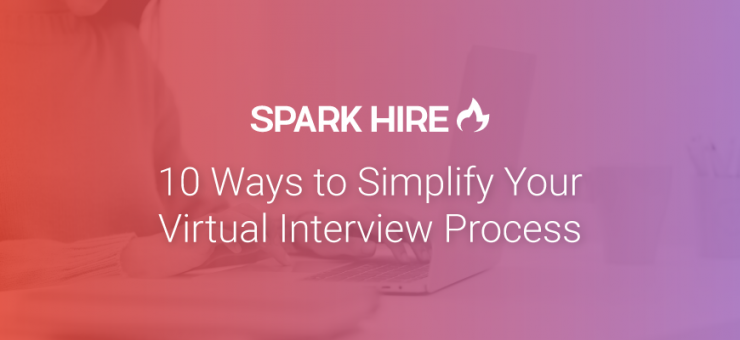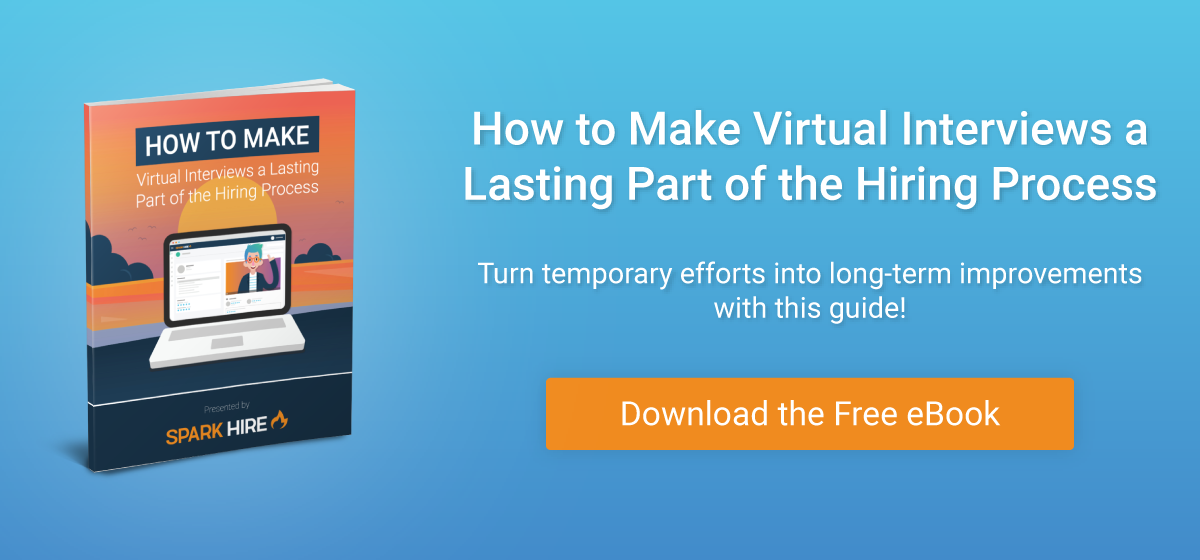There’s no question COVID-19 has changed the way we hire employees, from identifying qualified candidates to determining if they’re the right fit for the job at hand. The virtual interview process — once reserved for remote positions and long-distance candidates — has become mainstream seemingly overnight. And it’s here to stay, pandemic or no pandemic.
In fact, a recent survey of 140 global HR, talent, and business leaders by Cielo found that the majority (82%) of hiring managers will continue interviewing candidates via video post-pandemic. Overall, respondents felt that the combined impact of increased technology and remote working will result in faster, more streamlined, and more effective recruitment (59%) and cost-effective processes (60%). While the sample size is relatively small, it’s a sentiment that I think many of us can relate to as we begin to emerge from our current crisis.
Like most companies, you’ve probably been relying on virtual interviews for months now. The question is, are you prepared to maintain the virtual interview process in the long term? With 82% of 127 business leaders surveyed by Gartner saying they intend to allow remote working “some of the time” and 47% saying they plan to allow it full-time, you should be.
For many of us, remote work is a new — and welcome — reality. And our interview processes should reflect the shift to a more hybrid workforce. Whether your company has embraced the virtual interview process for the short term or the foreseeable future, finding a way to simplify it for both hiring professionals and job candidates is key.
With that said, here are a few strategies that can help make the virtual interview process simpler for everyone:
Hiring Pro Experience
With the massive shift to remote work and an increased reliance on video technology in all areas of our lives, the virtual interview process isn’t likely to go anywhere anytime soon, regardless of when we return to the office. But these tips for hiring professionals can make the process much easier:
1. Have a plan
Regardless of whether your interview process is virtual or in-person, having a solid plan everyone on your team is on board with is essential. This means knowing what you’re looking for in a candidate (e.g., background/experience, skill set, personality traits, etc.), having a timeline in mind, establishing who will be involved in each step of the interview process, as well as what questions will be asked.
Discussing this information with your team beforehand not only ensures a smoother process but also creates a much more level playing field for candidates, simplifying the hiring decision.
2. Screen candidates from the get-go
You don’t have to wait until after you’ve sifted through dozens (or hundreds) of job applications before you begin screening job candidates and narrowing down who you’ll invite for a video interview.
Begin the screening process from the get-go by including screening questions within the job application. Including a prompt or two within your application, such as “Why are you interested in working with our company?” or “What does our mission mean to you?” can give you a better feel for the candidate’s goals, interests, and job fit earlier in the interview process. This is especially important in a completely virtual setting, since your interactions with the candidate may be more limited.
You might also consider incorporating one-way video interviews into your virtual interview process in place of traditional screening methods, such as phone interviews. This way, you can get to know a wide variety of candidates before moving them forward.
The one-way nature of this interview also simplifies the process for hiring professionals. They aren’t required to be present during the interview and can assess the candidate when it’s most convenient for them.
3. Use the right video platform
The most important part of any interview process is, of course, the interview itself. And while conducting virtual job interviews using video chat platforms such as Zoom, Whereby, and Skype can get the job done, they weren’t created with interviews in mind.
Video interview platforms, on the other hand, include features that make for a simpler virtual interview process. For example, some video interview platforms enable you to brand the experience with the ability to add your company’s logo or customize the colors.
Most importantly, these platforms typically allow you to record the entire interview. This means you can re-watch, pause, rewind, etc. and easily share and collaborate with your team. And no more note-taking means more time to really listen to and assess candidates.
4. Get your whole team involved
Both one-way and two-way video interviews make collaborating with your team easier than if you were to conduct an interview in person. For starters, both allow for real-time collaboration, rather than having to wait until an interview is over and the candidate has left to begin discussing their qualifications. And because both are recorded, you can easily send the interview links to co-workers for additional feedback.
Lastly, it’s much easier to get everyone involved in an interview that doesn’t require them to leave the comfort of their home or office. It’s for these reasons virtual interview processes are more collaborative.
5. Maintain a pipeline of top talent
If you really want to simplify the virtual interview process, consider maintaining a pipeline of top talent. This could include second-choice candidates, candidates who rejected a job offer, candidates who were great but weren’t the right fit for a particular position — you get the idea. Keeping their applications, video interview links, and additional materials/portfolio items on file makes it easier to get the ball rolling when a new position becomes available.
Candidate Experience
For many, COVID-19 put the job search on hold. While more people may have been in need of a job, less companies seemed to be hiring — understandably so.
As we slowly but surely return to a more stabilized workforce, companies will need to encourage job seekers to apply for their open positions. And what better way to do that than to make the process as safe and simple as possible. Here’s how:
1. Show candidates what you have to offer
The current crisis may make job seekers a bit more timid when it comes to the job search. They’re painfully aware of the fact many companies are freezing hiring or even laying employees off altogether. This makes it more important than ever to advertise your open positions and give job seekers an inside look into what it’s like to work for your organization (without them having to risk their health by visiting the office).
One of the best ways to do this virtually is through video. Create a “day in the life of a [job position]” video to give candidates a look at your company culture and what they can expect if they’re hired for the job. Or simply take candidates on a virtual tour of the office, even introducing them to some of the team members on their own videos.
When it comes to a virtual interview process, it’s even more important to highlight the human side of your business.
2. Make the application process as painless as possible
Apart from the actual interview, there’s nothing more intimidating to job seekers than an unnecessarily-long and tedious job application. Keep in mind job seekers are likely applying for multiple positions, so it’s unlikely they’re willing to spend hours on a single application.
So, keep it short and sweet. Ask for a resume, contact information, example work (depending on the position), and a screening prompt or two. Anything additional can be asked later in the interview process.
3. Incorporate scheduling tools
An easy way to simplify the virtual interview process for both job candidates and hiring professionals is with scheduling tools that eliminate the need for back-and-forth coordinating.
Syncing your team’s availability and allowing candidates to choose an available day and time slot is much more user-friendly than having to manually check everyone’s availability and hoping it aligns with the candidate’s.
4. Keep candidates engaged and informed
Whether it’s in response to a sudden turn of events or a job interview, it’s better to be proactive than reactive. Instead of waiting until a job candidate inevitably reaches out to you to follow up on their application or the status of the hiring process, consider sending automated updates to all of your applicants. Keeping them informed throughout the process not only avoids an influx of follow-up emails and phone calls but also it keeps candidates engaged.
In addition to automated updates, consider sharing your hiring timeline with candidates as well as how many steps there are in the process. While this ties you down to a specific deadline, it also keeps candidates from wondering where they stand.
5. Speed up the offer process
Sending a rejection email is no one’s idea of fun. And while an automated email can seem impersonal, having a few customizable templates ready to go is wise. It speeds up the process while also maintaining a relationship with the candidate. Here are just a few different templates you may want to consider having on hand:
- General rejection template (thanking the candidate but kindly letting them know you went with someone else)
- Runner-up template (praising the candidate and inviting them to apply for future positions and/or to connect on LinkedIn)
- Job offer template (this should be more catered to the individual)
Whether you’re looking to make a full or partial transition to remote work — and even if you’re not — having a simplified virtual interview process is going to be more necessary than ever before in order to remain competitive in this “new normal.” COVID-19 disrupted the workplace in more ways than one, but this is one change we hope is here to stay.












